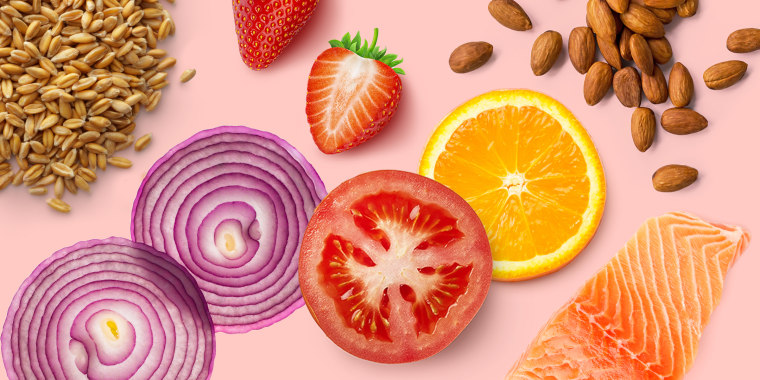We all want a healthy heart for life. Diet can make a huge difference in achieving that goal.
On Tuesday, the American Heart Association released its list of the 10 key components that make up a heart-healthy eating pattern.
The advice may sound familiar, but the scientific statement — published in the journal Circulation — focuses on “the balance, variety and combination of foods” people eat, rather than individual foods or nutrients.
“It does not need to be complicated, time consuming, expensive or unappealing,” said Alice Lichtenstein, chair of the scientific statement writing group and director of the cardiovascular nutrition team at the Human Nutrition Research Center on Aging at Tufts University in Boston, in a statement.
“You can absolutely adapt a heart-healthy diet to different lifestyles, including one that incorporates eating out at restaurants. It might take a little planning, however, after the first few times it can become routine.”
It’s essential to start eating this way early in life and stick with it for the long term, the authors wrote.
Here are their 10 recommendations:
1. Maintain a healthy weight throughout life
This means balancing food and calorie intake with physical activity. The authors advised a healthy dietary pattern that includes portion control coupled with at least 150 minutes of moderate physical activity per week. People should eat less as they age because daily energy needs decrease by up to 100 calories with each decade.
2. Eat lots of fruits and vegetables
Diets rich in fruits and vegetables — whether fresh, frozen, canned or dried, but “with the exception for white potatoes” — are associated with a reduced risk of heart disease, the authors noted. They recommended choosing deeply-colored produce such as leafy greens and peaches to get more nutrients.
It’s also better to eat whole fruits and vegetables than juice them because the whole form contains more fiber and makes a person feel fuller. It's best to get a full range of nutrients from food rather than supplements.
3. Choose whole grains
Eating whole grains such as brown rice instead of refined grains such as white rice improves cardiovascular risk factors, studies show. Products made with at least 51% whole grains are typically classified as whole-grain.
4. Include healthy sources of protein
This means mostly protein from plants, such as legumes and nuts, which are also good sources of fiber. Legumes include soybeans (which can be in the form of edamame and tofu), lentils, chickpeas and split peas.
At this time, plant-based meat alternatives require “some caution” because many are ultra-processed and contain added sugar, saturated fat, salt, stabilizers and preservatives, the authors wrote.
Regular intake of fish and seafood — at least two servings per week — was also recommended because of its omega-3 fatty acid content, though fried fish didn’t provide the same heart health benefits as baked or steamed fish.
It’s best to replace full-fat dairy with low-fat or non-fat options to reduce consumption of saturated fat.
If you still want to eat meat and poultry, stick with lean cuts. Limit red and processed meats such as bacon, sausage, hot dogs and salami to reduce salt, saturated fat and cholesterol.
5. Use liquid non-tropical plant oils
This means olive, canola, sunflower, soybean, corn, safflower and sunflower oils, plus fat found in walnuts and flax seeds.
Avoid coconut oil, butter, lard and partially hydrogenated fats.
6. Choose minimally-processed foods
These don’t contain added salt, sugar, fats, artificial colors, flavors or preservatives. A fresh apple, a home-cooked fish filet, bagged spinach and raw, unsalted nuts are examples of unprocessed or minimally-processed foods.
Store-bought cakes, cookies and frozen pizza are examples of highly-processed foods.
7. Minimize sugary drinks and foods
Added sugars — such as glucose, dextrose, sucrose, corn syrup, honey, maple syrup and concentrated fruit juice — have been associated with a higher risk of Type 2 diabetes, coronary heart disease and excess weight.
Drinks with low-calorie sweeteners may not be better alternatives because there have been “mixed findings” about their impact on body weight and metabolic outcomes, the authors noted.
8. Choose or prepare foods with little or no salt
This is because there is a “direct, positive relationship” between salt intake and blood pressure, the statement noted. Eating less salt lowers blood pressure — an effect that’s greater in people who are Black, middle-aged and older, and those with hypertension.
In the U.S., processed foods, meals prepared outside the home, packaged foods and restaurant foods account for almost three-quarters of total dietary sodium, the statement noted. Remember: Even foods labeled 100% whole-wheat or organic can be high in salt.
9. Limit alcohol consumption
There’s a “complex” relationship between drinking alcohol and heart disease, the authors acknowledged.
Although low intake of alcohol has been associated with a lower risk of coronary heart disease and ischemic stroke, the AHA does not support starting drinking at any level, “given the uncertainty about net health effects.”
If you don’t drink, don’t start; if you already do, limit it to one drink per day.
10. Stick with this guidance wherever food is prepared or eaten
Food is all around us so remember this list each time you make a choice. It can make a difference between a healthy and an unhealthy heart.




